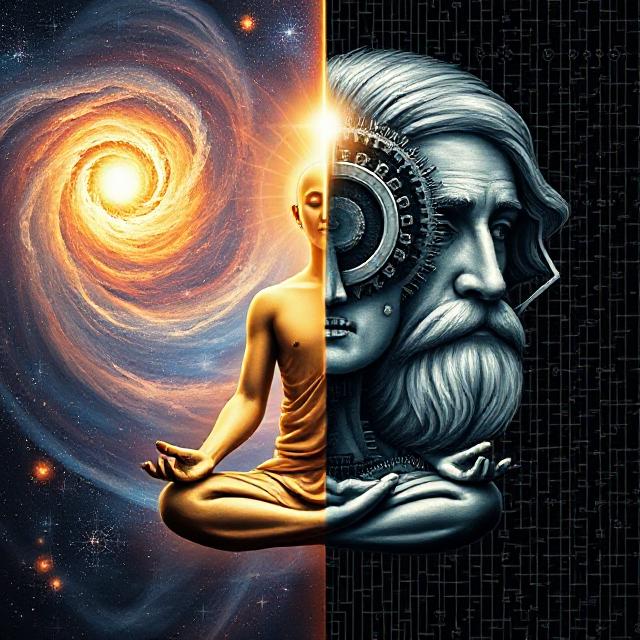
Table of Contents
Eastern Monism vs Western Dualism: Mind, Matter, and Unity
At the heart of philosophy lies one of its oldest and most enduring questions: What is the fundamental nature of reality? The contrast between Eastern monism vs Western dualism unveils two radically different metaphysical visions. While monism sees the cosmos as unified and indivisible, dualism divides existence into two distinct realms—typically mind and body, spirit and matter, or self and other.
These perspectives are not merely abstract theories. They shape how civilizations approach everything from medicine and psychology to ethics, spirituality, and science. To understand them is to grasp the roots of how cultures define existence itself.
I. Eastern Monism: One Reality, Many Appearances
A. What is Monism?
Monism asserts that all reality is one, a unified whole. The diversity we perceive is an illusion born of limited understanding. In Eastern thought, monism often takes a spiritual or metaphysical form:
- Hindu Advaita Vedanta: Brahman is the ultimate, formless reality; Atman (self) is not separate but identical with it.
- Buddhism (especially Mahayana): Emptiness (shunyata) points not to nihilism, but to the interdependent, non-dual nature of all things.
- Taoism: The Dao is the unnameable source of all that exists. Apparent opposites (yin and yang) are inseparable aspects of the same whole.
“That art Thou.” (Chandogya Upanishad)
B. Implications for Self and World
In monism, distinctions like self vs other, spirit vs matter, or even good vs evil are seen as conceptual overlays, not ultimate truths. This has deep consequences:
- The ego is illusory; enlightenment comes from dissolving the sense of separation.
- Morality arises from harmony, not law or commandment.
- Healing and wholeness are about restoring balance, not fixing broken parts.
C. Mystical Unity
Monism often leads to mystical experiences where boundaries melt away. In meditation, ritual, or silence, practitioners seek to transcend duality:
- The yogi becomes one with Brahman
- The Zen monk dissolves into emptiness
- The Taoist forgets the self and flows with the Way
II. Western Dualism: A World Divided
A. What is Dualism?
Dualism posits that reality consists of two fundamental substances or realms. The most famous version comes from Descartes:
“I think, therefore I am.”
Here, mind (res cogitans) and matter (res extensa) are two distinct things. Other dualisms include:
- Good vs evil (Zoroastrianism, Christian theology)
- Body vs soul (Plato, Augustine)
- Nature vs culture
B. Implications for the Self and Ethics
In dualism:
- The mind is elevated as the true self
- The body is often seen as lower, corrupt, or animalistic
- Salvation or moral purity involves overcoming the physical, transcending the material world
This view influences:
- Western medicine, which separates mind and body
- Judicial systems, which assign responsibility to inner intentions over external factors
- Religious salvation, which emphasizes the soul’s journey beyond the flesh
C. The Scientific Revolution and Materialism
Descartes’ dualism paved the way for mechanistic science, where nature was a machine to be studied, dissected, and controlled. Ironically, later thinkers moved toward materialism, denying the independent existence of mind altogether.
Yet the original dualism—matter vs spirit, fact vs value—still lingers in Western thought.
III. Comparative Table: Eastern Monism vs Western Dualism
| Feature | Eastern Monism | Western Dualism |
|---|---|---|
| Ultimate Reality | One, unified essence (Brahman, Dao, Emptiness) | Two substances: mind and matter |
| Self and Ego | Illusory, to be dissolved | Real and central to identity |
| Spiritual Path | Union, merging, balance | Transcendence, control, redemption |
| Ethics | Harmony, compassion, natural alignment | Law, commandment, moral struggle |
| Medicine | Holistic, energetic, mind-body unity | Compartmentalized, symptom-based |
| Knowledge | Intuitive, mystical, experiential | Rational, analytical, empirical |
IV. Can They Be Reconciled?
A. Complementary Perspectives
In an age of global exchange, many thinkers propose integrative models:
- Ken Wilber’s integral theory tries to combine spiritual insight with scientific rigor.
- Quantum physics challenges hard dualisms, hinting at observer-dependence and interconnectivity.
- Psychologists like Carl Jung and Abraham Maslow explored how Eastern oneness and Western individuation might both be valid stages of development.
B. Critiques of Each
- Monism may underplay the value of difference, individuality, and moral conflict
- Dualism can foster alienation, repression, and a split psyche
A richer understanding may lie in seeing duality as a play within unity. As the Dao De Jing puts it:
“The ten thousand things arise together, and I watch their return.”
Conclusion: Two Eyes, One Vision
The debate between Eastern monism vs Western dualism is more than metaphysical. It’s about how we live, relate, heal, and evolve. Where monism invites us to dissolve boundaries, dualism calls us to navigate them responsibly.
In the end, both worldviews can serve as lenses—one wide and holistic, the other focused and precise. When used together, they help us see reality not as one or two, but as infinitely rich.
